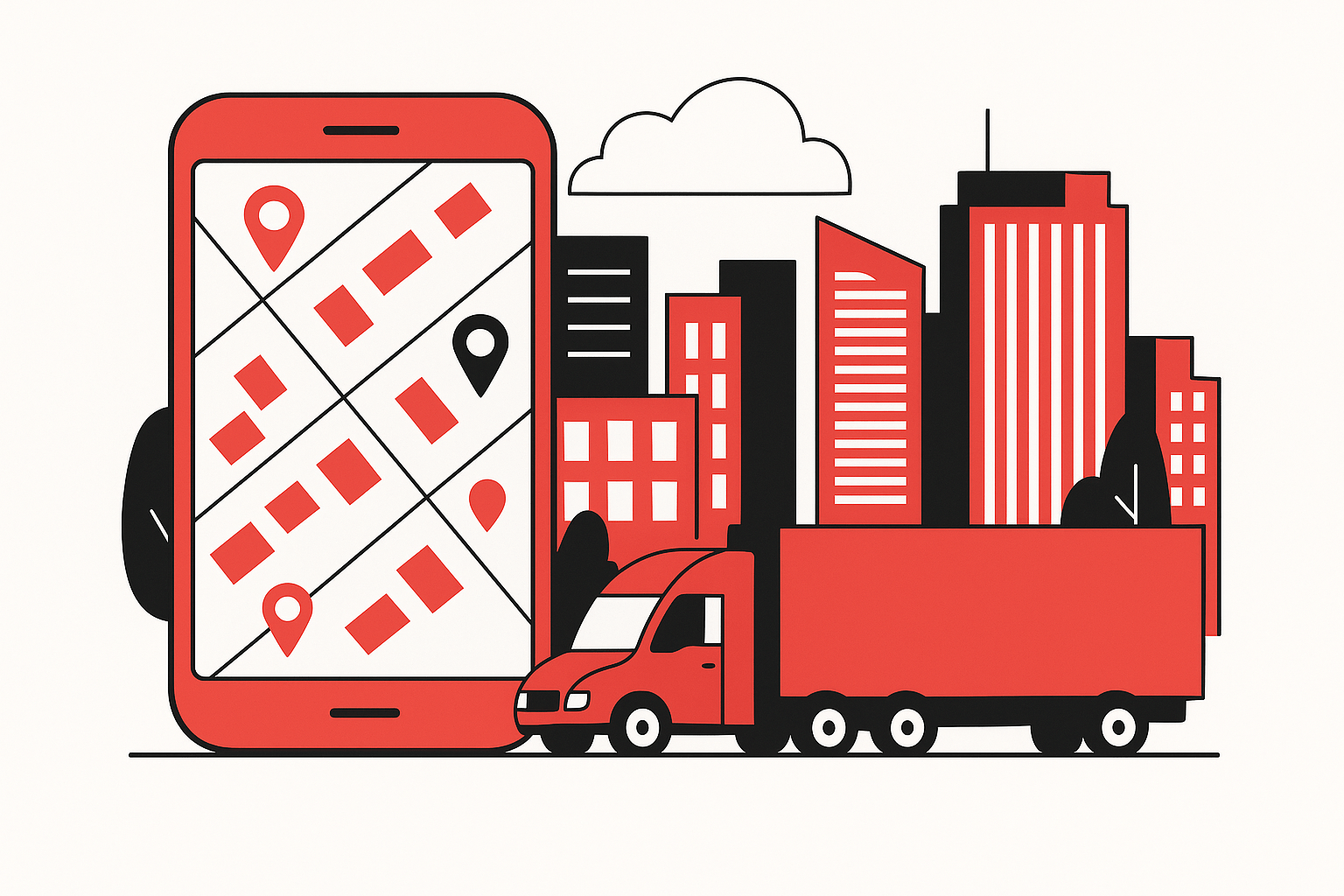The logistics industry is going digital – and that too quickly.
With the success of Uber Freight, more and more businesses are investing in logistics app development – aiming to automate manual processes, streamline operations, and enhance delivery speed.
If you’re also considering building an app like Uber Freight, this guide helps you explore everything you’d need to know: how to build an app like Uber for trucking, the logistics app development cost, and freight app features that matters the most – it has got all covered.
Whether you run a transport company or launching a startup, this blog post is to help simplify your app development challenges. Let’s dive in to discover how you can build a high-performance, scalable app like Uber Freight – and what it takes to compete in the growing shipping and trucking market.
Build Your Own Uber for Trucking
Launch a custom freight app built for speed, scale, and success.
How to Build an App like Uber Freight – Step-by-Step Guide
Developing a logistics app like Uber Freight demands more than just code—it takes strategy, domain knowledge, and technology alignment. Here’s a step-by-step guide that breaks it down into meaningful, value-driven actions.
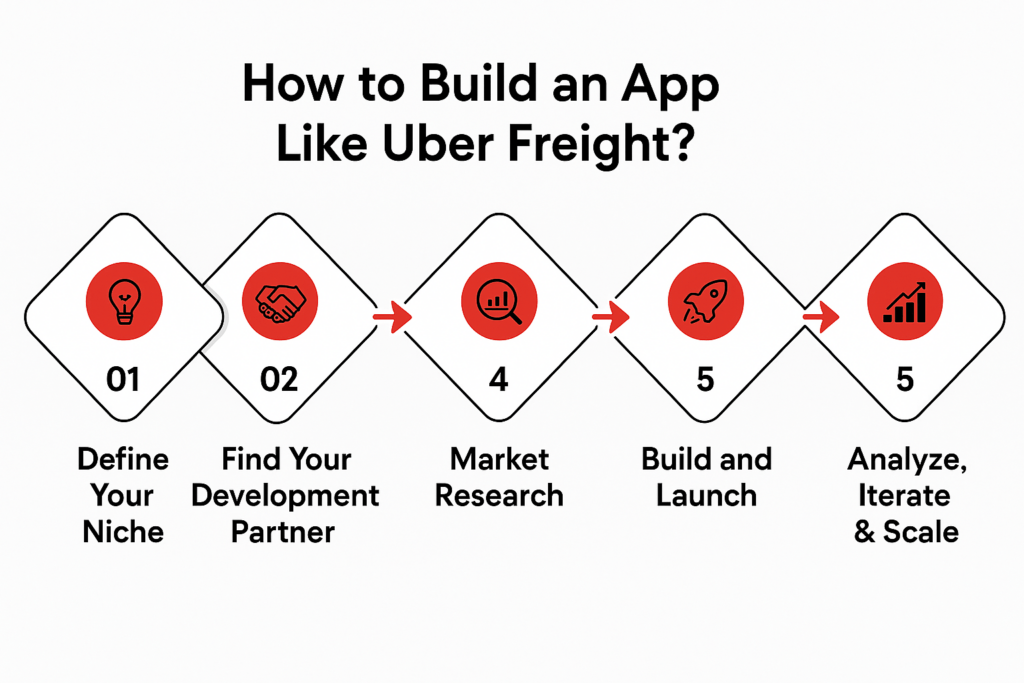
Step 1: Define Your Niche (FTL, LTL, Courier, Last Mile)
Before diving into development, clearly define your logistics niche. Whether you’re focusing on full truckload (FTL), less-than-truckload (LTL), courier, or last-mile delivery, your app’s design, features, and monetization will depend heavily on this choice. This clarity helps custom-build your freight app features for specific user needs, improving retention and market fit from day one.
Step 2: Find a Logistics App Development Partner
Choose an experienced team that specializes in Uber freight app development and understands the logistics ecosystem. Look for a partner like AppVerticals that offers end-to-end development— from ideation and UX to deployment and scaling. A capable team ensures your app is not only functional but optimized for high uptime, user load, and real-time data sync, which are critical in modern truck logistics apps.
Step 3: Validate the Idea with Market Research
Before you invest heavily, validate your concept through competitive analysis and interviews with shippers, carriers, and dispatchers. Understand user pain points with manual freight processes, and use these insights to design a user-friendly freight app or trucking app that addresses real gaps in the market. This is where real ROI begins—building what users actually need.
Step 4: Build and Launch the MVP
Focus on an MVP (Minimum Viable Product) that includes must-have features like load posting, job matching, in-app chat, and live tracking. The MVP should be lean but functional—your launchpad to real-world feedback. Keep your logistics app development cost in check by prioritizing features while ensuring the user experience is intuitive and performance is robust.
Step 5: Analyze, Iterate, and Scale Smart
Post-launch, use analytics to track user behavior, booking patterns, and driver performance. Optimize feature sets based on this data—maybe that’s introducing AI-based load recommendations or integrating predictive ETA algorithms. This continuous improvement approach transforms your MVP into a fully scalable Uber for logistics app, positioning you ahead of traditional shipping models and competition.
Ready to Digitize Your Logistics Operations?
Launch your own Uber-style freight app tailored to your business needs.
How Much Does It Cost to Build an App like Uber Freight?
Understanding the logistics software development cost is crucial before diving into your project. Whether you’re building a minimal version or a fully functional platform, costs vary depending on features, tech stack, development region, and post-launch support.
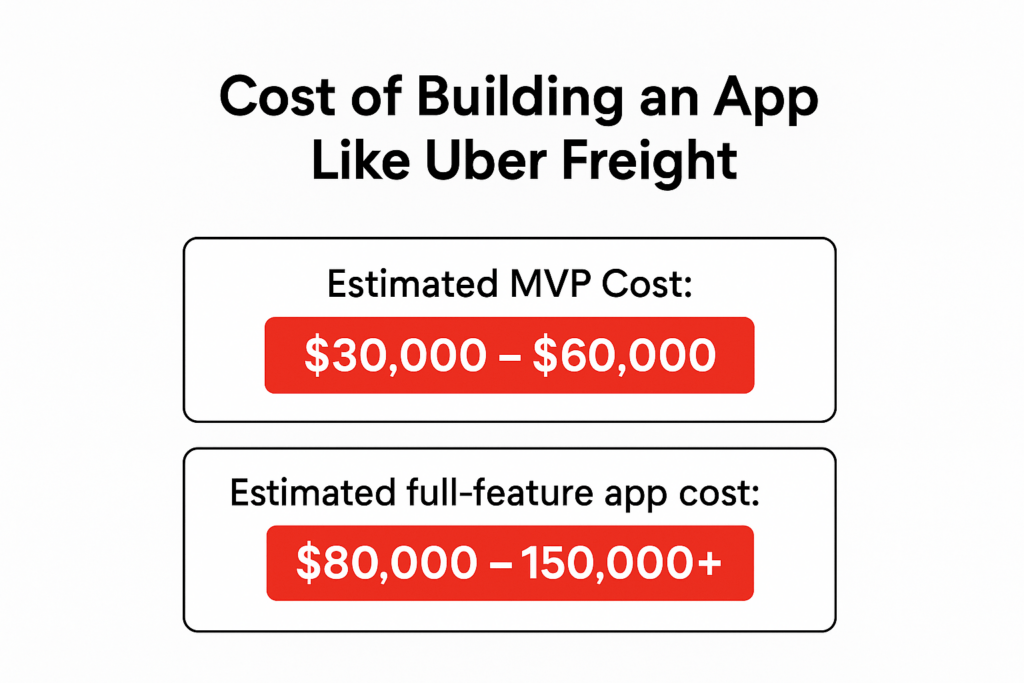
MVP Cost – Basic Functionality
An MVP (Minimum Viable Product) covers essential freight app features like:
- Carrier/Shipper registration
- Load posting and bidding
- Real-time tracking
- In-app messaging
- Basic admin dashboard
Estimated MVP cost: $30,000 – $60,000
This is ideal for startups looking to validate their idea and enter the Uber for logistics app market with lower upfront investment.
Full-Featured Logistics App Cost
A full-scale Uber freight app development solution includes:
- Smart pricing engine (dynamic Uber truck rates)
- Document management (BOLs, invoices)
- Route optimization
- Advanced analytics & reporting
- Payment gateway integration
- Integration with TMS/ERP systems
Estimated full-feature app cost: $80,000 – $150,000+
This is best suited for scaling logistics companies that need powerful automation and enterprise-grade performance.
Cost Ranges by Region
| Region | Average Hourly Rate | MVP Cost Range | Full App Cost Range |
| US/Canada | $1000 – $180/hr | $60,000 – $90,000 | $150,000 – $250,000+ |
| Eastern Europe | $40 – $75/hr | $30,000 – $60,000 | $80,000 – $140,000 |
| South Asia | $25 – $50/hr | $20,000 – $40,000 | $60,000 – $100,000 |
Outsourcing development to Eastern Europe or Asia can significantly reduce your logistics mobile app development cost without sacrificing quality—if you choose the right partner.
Ongoing Maintenance Costs
Post-launch costs include bug fixes, server upkeep, API updates, and feature enhancements. On average, set aside:
Monthly maintenance: $1,500 – $5,000/month depending on app complexity.
Pro tip: To control long-term costs, start with a modular approach—build an MVP with core freight app features, test market fit, and scale gradually.
Curious About the Cost to Build Your Freight App?
Get a quick estimate based on your feature requirements and tech stack.
Key Features You Need in a Freight App (With Unique UX Tips)
Whether you’re planning Uber freight app development or a custom truck logistics app, your feature set must cater to three user roles—shippers, drivers, and admins. Here’s what a high-performing freight app must include, along with practical UX enhancements that can help crafting unique customer experiences.
Shipper-Side Features
These features help businesses schedule, track, and manage freight with ease:

- Load Posting: Shippers can publish load details instantly, with filters like weight, size, and delivery deadlines.
- Real-Time Tracking: Integrated GPS allows shippers to track truck movement live—vital for proactive planning.
- Secure Payment Gateway: Ensure seamless transactions with Stripe, PayPal, or direct bank APIs.
UX Tip: Use the Google Maps API to provide interactive route visualization with ETA updates. This enhances transparency and builds trust.
Perfect for any Uber for logistics app targeting transparency and automation.
Driver-Side Features
Empower carriers with tools that reduce manual effort and streamline deliveries:
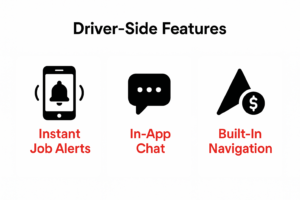
- Instant Job Alerts: Drivers receive push notifications when new loads near them become available.
- In-App Chat with Shippers: Enables real-time coordination for smoother delivery.
- Built-in Navigation: Turn-by-turn routing, detour alerts, and fuel stop suggestions.
- ePOD Uploads: Capture and upload electronic proof of delivery right from the app.
UX Tip: Implement a voice-based UI so drivers can interact with the app while keeping their hands on the wheel—especially useful during navigation or ePOD uploads.
Core for any freight app or Uber cargo platform designed with driver safety in mind.
Admin Panel Features
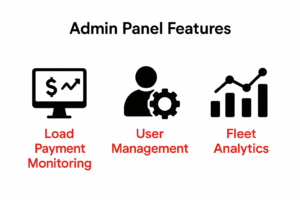
The backbone of your logistics app development, the admin side ensures smooth operations and insights:
- Load & Payment Monitoring: Track all in-transit shipments, failed loads, and payment statuses in real time.
- User Management: Approve, suspend, or verify shippers and drivers based on KYC, activity, or performance.
- Fleet Analytics: Advanced reporting tools with KPIs like delivery success rate, delays, and driver availability.
UX Tip: Incorporate heatmaps and filters to display high-traffic regions, frequent delivery bottlenecks, or idle fleet zones.
Whether you’re learning how to build an app like Uber for trucking or scaling an existing solution, embedding these features with thoughtful UX can transform user retention and operational efficiency.
Unique Feature Add-ons to Outperform Uber Freight
To set your logistics app development apart from competitors like Uber Freight, you’ll need to integrate unique, high-value features that improve user experience and streamline operations. Here are some innovative add-ons that will help your freight app stand out in 2025:
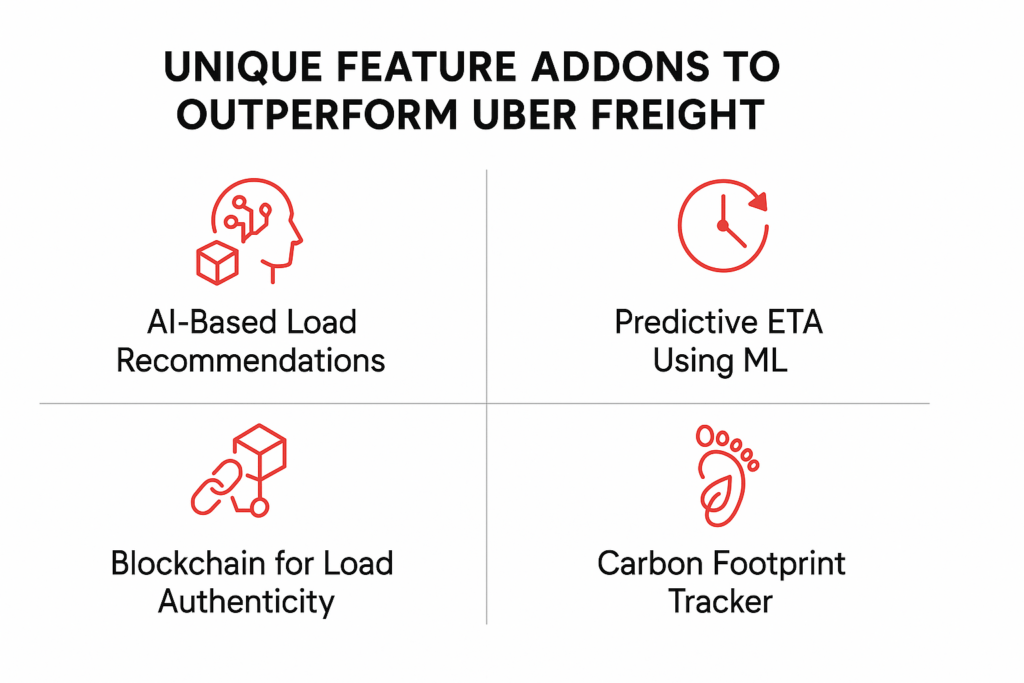
1. AI-Based Load Recommendations
Using machine learning algorithms, you can offer AI-based load recommendations to drivers based on their historical routes, preferences, and current location. This feature helps drivers find the most relevant and profitable loads instantly, improving efficiency and reducing downtime.
Why it’s valuable: This predictive capability boosts driver productivity and ensures optimal load matching, saving time and fuel costs.
2. Predictive ETA Using Machine Learning
Leverage predictive analytics to enhance Uber truck rates by predicting ETAs more accurately. Machine learning algorithms can account for real-time traffic conditions, road closures, weather patterns, and historical delivery data to adjust ETAs dynamically.
Why it’s valuable: A more precise ETA improves planning for both shippers and recipients, enhancing the customer experience and reducing waiting times.
3. Blockchain for Load Authenticity
Incorporate blockchain technology to authenticate and verify loads, reducing the risk of fraud. Blockchain can track each shipment’s journey, providing transparent, immutable records of every transaction.
Why it’s valuable: This ensures the security of load documentation, builds trust, and simplifies audits—ideal for businesses looking for secure, transparent freight management.
4. In-App Document Scanner for Drivers
An integrated in-app document scanner allows drivers to capture and submit important paperwork—such as bills of lading (BOL), delivery receipts, or inspection reports—directly through the app. This minimizes paperwork and speeds up the documentation process.
Why it’s valuable: Reduces administrative overhead for both drivers and dispatchers, allowing for quicker settlements and fewer errors.
5. Carbon Footprint Tracker (Green Logistics)
As sustainability becomes a key consideration in modern logistics, integrating a carbon footprint tracker can show real-time CO2 emissions based on distance traveled, cargo type, and route choice. This feature encourages eco-friendly practices and allows businesses to offset their environmental impact.
Why it’s valuable: With growing demand for green logistics, this feature helps companies align with sustainability goals, which is an attractive selling point for eco-conscious clients.
By incorporating these innovative add-ons into your freight app, you not only improve user satisfaction but also position your solution as a forward-thinking leader in logistics tech. Whether it’s using AI for predictive insights or leveraging blockchain for enhanced security, the power of modern mobile app development is helping redefine the digital transformation – helping you outperform Uber Freight in the competitive logistics market.
Technology Stack for Building Freight Apps
When developing a logistics app like Uber Freight, selecting the right tech stack is crucial for ensuring scalability, performance, and user experience. Below is an overview of the key technologies typically used to build and scale a freight app.
Frontend: React Native / Flutter
For a seamless user experience across both iOS and Android, React Native and Flutter are the go-to frameworks. These frameworks allow for fast development, reducing the need for separate codebases for each platform while maintaining high performance.
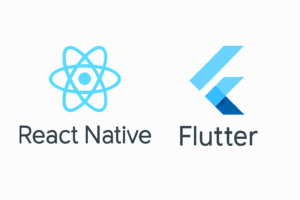
- React Native: Ideal for cross-platform development, enabling you to write code once and deploy it on both iOS and Android.
- Flutter: Google’s framework provides a rich set of pre-designed widgets, great for building aesthetically pleasing apps with native performance.
Backend: Node.js / Python (Django), Express
The backend development is the powerhouse of any freight app, handling data processing, authentication, and real-time updates. These frameworks provide the necessary flexibility and performance for Uber logistics apps.
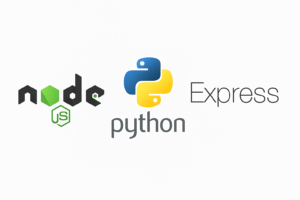
- Node.js: A JavaScript runtime environment, perfect for handling asynchronous requests in real time (e.g., tracking, notifications).
- Python (Django): Known for its scalability and robustness, Django is ideal for more complex backend systems, especially for data-heavy logistics operations.
- Express: A minimalistic Node.js framework used for fast API development, allowing for efficient handling of HTTP requests.
Database: PostgreSQL / MongoDB
For managing large volumes of data, such as shipment records, user profiles, and transactions, reliable databases are essential.
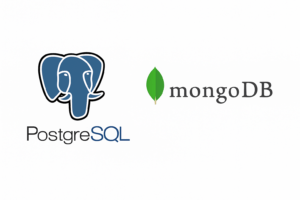
- PostgreSQL: A relational database known for its robustness and ACID compliance, making it ideal for transactional applications like Uber freight logistics.
- MongoDB: A NoSQL database suited for apps that require high scalability, flexibility, and quick access to unstructured data.
APIs & Integrations: Twilio, Google Maps, Stripe, AWS S3, SendGrid
Integrating third-party services and APIs ensures your app performs well and provides additional functionalities that enhance the user experience.
- Twilio: For real-time messaging and communication, essential for notifications and chat features between shippers and drivers.
- Google Maps API: A key integration for location tracking, route visualization, and real-time updates for shipments.
- Stripe: For secure payment processing and handling financial transactions between shippers and drivers.
- AWS S3: For storing documents like Bills of Lading (BOLs) or images securely and efficiently.
- SendGrid: An email delivery service for sending transaction or notification emails to users.
Cloud Hosting: AWS, GCP, Azure
Cloud hosting platforms provide the necessary scalability and reliability to handle large datasets, especially for logistics apps that track real-time freight movements.
- AWS (Amazon Web Services): One of the most popular choices for cloud hosting, offering a range of services for compute power, storage, and database management.
- GCP (Google Cloud Platform): Known for its machine learning tools and Kubernetes services, GCP is a great choice for apps that need real-time analytics and predictive features.
- Azure: Microsoft’s cloud platform, known for its enterprise-grade services and seamless integration with other Microsoft tools.
Choosing the right technology stack is crucial for developing a scalable and feature-rich Uber freight app that can adapt to the growing demands of the logistics industry.
Why Build an App like Uber Freight in 2025?
The global logistics industry is majorly shifting.
Moving into 2025, the demand for on-demand logistics and app-based freight solutions is at an all-time high. Businesses are quickly responding to the shift and replacing manual, outdated processes with digital innovation to stay in competition.
Market Trends in Digitized Freight
Uber freight logistics has undergone significant growth over a short period of time, showcasing the potential of platforms that can connect carriers and shippers in real-time. Recent industry reports suggest the digital freight market would grow in billions over the next few years. Businesses today need apps that offer transparency, automation, and instant pricing – a combination that traditional freight management lacks.
On-Demand Logistics Is the New Normal
Just like Uber for logistics, modern shippers want real-time tracking, booking, and delivery options that can be executed without paperwork or delay. One-demand model has the potential to cut-down waiting times and enhance fleet utilization, benefitting both shippers and carriers.
Post-Pandemic Supply Chain Digitalization
Pandemic has exposed many inefficiencies that remained a part of manual freight handling for many years. Ever since, supply chain digital transformation has accelerated. Businesses today are heavily investing in freight apps to reduce errors, enhance tracking, and respond to disruptions more quickly.
Manual Freight Booking vs. App-Based Automation
Manual freight booking is prone to errors, time-consuming, and expensive. In contrast, building an app like Uber Freight can automate tracking, matching, and payments – minimizing human effort and maximizing delivery reliability. It has simplified calculating the ROI of logistics mobile app development more than ever.
In 2025, building a trucking logistics app is not just an option – it’s become a strategic advantage.
Looking for a Development Partner You Can Trust?
See how we’ve helped logistics companies scale with custom apps.
Market Statistics: The Future of Freight Tech
The global logistics industry is majorly transforming, driven by the increased demand for efficient freight solutions and digital innovation.
Global Freight App Market Size & CAGR
The global freight matching market was valued at $47.31 billion in 2024, projected to reach an estimated $766.72 billion by the end of 2034. The growth substantially highlights the rising potential of platforms like Uber Freight – those are capable of matching shippers with carriers in real-time.
Investment Trends in Logistics Tech
Despite the dip observed in recent funding for venture capitals, the logistics tech sector continues to attract major investments. In the second quarter of 2024, supply chain tech startups secured a major $2.4 billion funding across 167 deals, highlighting a positive trend in industry. Notably, companies like Waabi, backed by Uber – are striving with autonomous trucking technology.
User Engagement Metrics for Apps like Uber Freight
While specific user engagement metrics for Uber Freight are proprietary, the platform’s success is evident in its widespread adoption and the efficiency it brings to freight operations. Features such as real-time tracking, transparent pricing, and automated booking have set new standards in the industry, prompting businesses to explore Uber freight app development to enhance their logistics capabilities.
Developing a freight app or truck logistics app similar to Uber Freight can position businesses at the forefront of this digital transformation, offering improved efficiency, scalability, and customer satisfaction.
Benefits of Creating a Custom Freight App
Building a freight app like Uber Freight can dramatically improve logistics efficiency for both shippers and carriers. Here are the top benefits of creating a custom freight app:
Real-Time Data Sync
- One of the most powerful advantages of a logistics app is the ability to sync data in real time.
- Shippers can track the status of their shipments live, adjusting schedules or making changes as needed.
- Carriers can update their status, report delays, or confirm deliveries instantly.
This real-time visibility into every stage of the delivery process ensures that all stakeholders are on the same page, reducing the chance of errors and delays.
Load Optimization
A custom freight app can optimize load assignments, reducing inefficiencies. By integrating smart algorithms, the app can:
- Suggest the most efficient routes based on real-time traffic and weather data.
- Automatically match the right trucks to the available freight based on capacity and location.
Load optimization not only saves fuel but also reduces empty miles, cutting costs for both shippers and carriers. It maximizes the potential of every shipment, increasing profitability.
Reduced Admin Work
Automating administrative tasks is one of the most valuable features of a freight app. With a custom logistics app:
- Invoice generation and payment processing are automated, reducing manual work.
- Document handling (e.g., Bill of Lading, proof of delivery) can be digitized, eliminating the need for paper-based processes.
- Real-time notifications reduce the time spent answering phone calls or responding to emails about the status of loads.
By reducing administrative overhead, businesses can focus on more strategic tasks, improving overall operational efficiency.
Transparent Delivery Pipeline
- With real-time updates and live tracking, both shippers and carriers benefit from a transparent, easy-to-follow delivery pipeline.
- Shippers can monitor delivery status, from the moment the shipment leaves the warehouse to when it’s delivered.
- Carriers have visibility into their schedules, helping them plan more effectively.
Transparency in the delivery process reduces confusion, enhances trust between all parties, and provides accountability throughout the supply chain.
Improved Carrier-Shipper Relationships
By facilitating seamless communication, automating routine tasks, and ensuring transparency, a freight app fosters stronger relationships between carriers and shippers.
- Shippers benefit from efficient load handling, faster delivery times, and fewer delays.
- Carriers can streamline their operations, ensuring fewer administrative tasks and clearer job expectations.
These enhanced relationships lead to better collaboration, repeat business, and long-term partnerships that benefit everyone in the logistics chain.
Bonus: What Makes a Successful Freight App?
To stand out in the competitive freight logistics market, your app must offer a great user experience and robust performance. Here’s what makes a freight app successful:
UX Consistency across Roles
Ensure a seamless and consistent user experience for all app roles—shippers, drivers, and administrators. Each role should have tailored but consistent interfaces that are intuitive and easy to navigate.
High Uptime
App reliability is crucial. High uptime ensures users can rely on the app for real-time tracking and booking, which is essential in the fast-paced logistics industry.
Transparent Pricing Models
Clearly display pricing information for shippers and carriers to build trust. Avoid hidden fees, and offer transparent rates to ensure users know what they’re paying for at every stage of the transaction.
Scalable Architecture
Design your app’s architecture to handle increased demand as your user base grows. A scalable backend ensures your app can handle higher volumes of shipments, drivers, and real-time data without compromising performance.
Build An App Like Uber Freight with AppVerticals
Ready to take the next step in revolutionizing logistics? AppVerticals is your trusted partner in mobile app development, offering expertise in building custom freight apps like Uber Freight.
Book a Free Discovery Call
Talk to our logistics app experts and validate your idea in 30 minutes.

